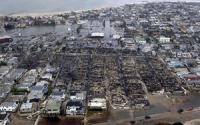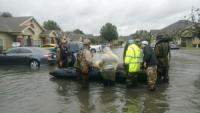-
Preparing low-income communities for hurricanes begins with outreach

Interviews with economically disadvantaged New Jerseyans in the areas hardest hit by Superstorm Sandy yield advice for future disasters.
-
-
Cities can save lives, resources by using a vulnerability reduction scorecard
A new planning tool enables communities to effectively reduce their vulnerabilities to hazards across their network of plans – including transportation, parks, economic development, hazard mitigation, emergency management and comprehensive land use.
-
-
Is Texas leading on disaster preparedness? Yes and no, experts say

During the first legislative session since Hurricane Harvey, state lawmakers are poised to make an investment in storm recovery and flood mitigation that some have described as unprecedented. But it’s more complicated than that.
-
-
Increasing household preparedness for disaster
Face-to-face workshops based on the psychology of behavior change and disaster preparedness can be used to prompt households to take action to protect themselves against disasters such as earthquakes, fires and floods.
-
-
Florida Panhandle counties less prepared for emergency than rest of state
found that the vast majority of counties in the Florida Panhandle were less prepared for emergency evacuation compared to the rest of the state. Of the 67 counties in Florida, 10 were rated as having weak levels of evacuation preparedness, and all of these counties were located in the Panhandle/North Florida. Eleven of 16 counties with moderately rated plans also were in this region. Only seven of the counties in the Panhandle had strong plans.
-
-
A milestone for forecasting earthquake hazards
Earthquakes pose a profound danger to people and cities worldwide, but with the right hazard-mitigation efforts, from stricter building requirements to careful zoning, the potential for catastrophic collapses of roads and buildings and loss of human lives can be limited. All of these measures depend on science delivering high-quality seismic hazard models. And yet, current models depend on a list of uncertain assumptions, with predictions that are difficult to test in the real world due to the long intervals between big earthquakes. Researchers have come up with a physics-based model that marks a turning point in earthquake forecasting.
-
-
RoboCup 2018: Testing methods used to evaluate rescue robots
Since 1997, several continents have played host to an international soccer tournament. No, not the World Cup — the RoboCup. Robots of all shapes and sizes test their “metal” in the world’s favorite sport. Engineers and fans from across the globe have gathered to watch hunks of autonomous steel try to nudge a ball into a miniature net.
-
-
Disaster planning saves lives
There are a lot of scary threats in the world—extreme weather, terrorist attacks, deadly infectious diseases, mass shootings—but if health care organizations plan ahead for such disasters, lives can be saved. The first step for health care organizations preparing for emergencies is to accurately assess the kinds of hazards they may face, such as flooding, power outages, or violence, says an expert.
-
-
U.S. “prepping” culture influenced by events, not apocalyptic visions
The culture of preparing for disasters in the United States is usually portrayed as a delusional response to the belief in the imminent long-term collapse of society due to irrational fears of foreign invasions, the conspiratorial plans of New World Orders or a religious apocalypse. New research finds most people hoarding items such as food and water do so “just in case,” rather than because of deeply held, irrational beliefs that society is on the verge of an imminent collapse.
-
-
Predicting volcanic eruptions
Concern over the potential imminent eruptions of Earth’s supervolcanoes, like Taupo in New Zealand or Yellowstone in the United States, may be quelled by the results of a new study suggesting that geological signs pointing to a catastrophic eruption would be clear far in advance.
-
-
U.S. health security preparedness improved, but some regions lagging
A national snapshot used to gauge the health of the nation’s health security and emergency preparedness found that readiness has improved significantly over the past five years, but earlier identified gaps remain, with some parts of the country lagging.
-
-
Planning for hurricanes as weather patterns change
We’re all aware of the impact of intense weather systems that make headlines, like 2017’s hurricanes Harvey and Irma. But even slight adjustments to weather patterns—like historic changes in precipitation levels and the increasing frequency of heat waves—can drastically change living conditions.
-
-
Preventing hurricanes using air bubbles
In recent years we have witnessed intense tropical storms that have taken many thousands of lives and caused massive destruction. For example, in 2005, hurricane Katrina killed more than 2,000 people and caused damage estimated to be in the billions of dollars. In 2016, hurricane Matthew swept across Haiti, taking 852 lives and destroying many towns on the island. Many people have tried to find ways of preventing hurricanes before they make landfall. Norwegian researchers believe that the answer lies in cold bubbles.
-
-
Budgeting for medical countermeasures is essential for preparedness
Preparedness against a chemical, biological, radiological, or nuclear (CBRN) threat requires a sustained and multi-pronged approach by both the public and private sectors. An essential component of this strategy is the development, procurement, and stockpiling of diagnostic tests, drugs, and vaccines in response to a potential event, as well as the ability to distribute these products where needed.
-
-
Houston-area officials approved a plan for handling a natural disaster — then ignored it
Seven months before Hurricane Harvey inundated the Houston area with a trillion gallons of water and led to widespread criticism of the Red Cross, Harris County adopted a disaster-preparation plan whose key assumption was that the Red Cross would be slow to act. “In a major disaster where there is widespread damage, the local resources of the Red Cross may be overwhelmed and not available immediately,” stated the plan. “It may be upwards of seven days before the Red Cross can assume a primary care and shelter role.” But in the seven months between the plan’s passage and the landfall of Harvey, the county took few steps to implement its strategy. Indeed, when dire flooding forced thousands of people from their homes, 3,036 emails obtained in a public records request suggest, officials didn’t even seem aware that a plan existed.
-
- All
- Regional
- Water
- Biometrics
- Borders/Immig
- Business
- Cybersecurity
- Detection
- Disasters
- Government
- Infrastructure
- International
- Public health
- Public Safety
- Communication interoperabillity
- Emergency services
- Emergency medical services
- Fire
- First response
- IEDs
- Law Enforcement
- Law Enforcement Technology
- Military technology
- Nonlethal weapons
- Nuclear weapons
- Personal protection equipment
- Police
- Notification /alert systems
- Situational awareness
- Weapons systems
- Sci-Tech
- Sector Reports
- Surveillance
- Transportation
Advertising & Marketing: advertise@newswirepubs.com
Editorial: editor@newswirepubs.com
General: info@newswirepubs.com
2010-2011 © News Wire Publications, LLC News Wire Publications, LLC
220 Old Country Road | Suite 200 | Mineola | New York | 11501
Permissions and Policies
Editorial: editor@newswirepubs.com
General: info@newswirepubs.com
2010-2011 © News Wire Publications, LLC News Wire Publications, LLC
220 Old Country Road | Suite 200 | Mineola | New York | 11501
Permissions and Policies
